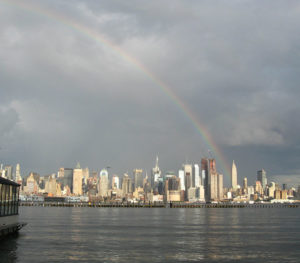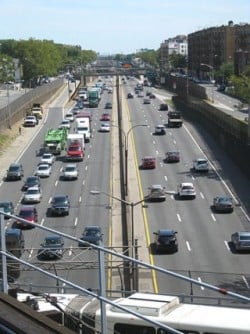Decentralization fever
In America, in the post-World War II-era, a new wave of development captured the country’s imagination. This wave of development within a few decades had swept the nation. This wave of development was termed suburbanization. Another word for suburbanization: decentralization.

The whole idea behind suburbanization is the desire for residents, businesses and even industry to vacate the world of the inner city and relocate to areas outside the city periphery. Vacating the inner core, gave those that did an opportunity to start anew, a way to leave crime, any industry-produced smoke and grime, and in many cases the associated squalid living conditions behind.
One type of suburbanization happened in New York taking on the name Levittown. Levittowns (yes there was more than one) was essentially a neighborhood where all homes were built using the same floor plan, as I understand it. The so-called mass-production or cookie-cutter home pattern in one neighborhood had no trouble being easily replicated in another and as it turned out, more such Levittowns surfaced in Pennsylvania, Puerto Rico, New Jersey and Maryland adorned with the common characteristic features as, according to information on Wikipedia, verdant lawns, white painted border fences and the houses came outfitted with the latest in electric and electro-mechanical furnishings like toasters and washers and driers, respectively, for example, these being standard fare – a big selling point.
It is not too difficult to imagine that this way of life would spread and it did. Take-offs on this basic theme abounded.
For many living the suburban lifestyle had its advantages. Neighborhood schools were built with other services likewise provided. And, the neighborhood roads typically connected to highways.
Likewise, for many of the bread-winners of the suburban houses, their jobs were still located in the inner cores of the neighboring cities with which these neighborhoods had a connection. Highway driving was part and parcel of those folks’ commutes. School buses, meanwhile, provided transportation to and from neighborhood schools for the family children living in these suburban enclaves; that is, if, the walk to and from school was too far.

But, as more subdivisions sprouted up, highway use increased, more often than not, to the point that traffic and travel got bogged down.
To add to the predicament, transit systems, not buses, mind you, but streetcar and interurban networks were, one by one, falling out of public favor and, as a result, lost patronage. Many shut down with only a handful of networks surviving.
Adding to the dilemma were increased sales of automobiles because of the affordability of such – they were all of a sudden within the reach of many.
For many, this was “the life” and living this way thus became a highly sought-after American ideal. Information on Wikipedia indicates 50 percent of the U.S. population now resides in suburbia. Non-rural inhabitation is estimated to broaden to 67 percent or greater by 2050.
Congestion-busting
The more suburbia grows the more it feeds the traffic and traffic-congestion-building machine and, the more that happens, the greater the negative effect on area air and on human, animal and plant health by extension.
So, what can be done to counteract or at least help mitigate the decentralization part of driving?
In the city where I reside, I might have opted for a life in downtown. But weighing all of the factors – lack of even adequate retail; eating establishments; grocery stores; entertainment venues; a relatively primitive public transportation system and limited job opportunities – I chose to live uptown instead.
This type of living by and large for me necessitates that I drive if I need to be out and about. As a writer, I do all of my composing (on paper), and posting and editing (using computer) from my home. So, there is telecommuting, which is also known as teleworking, and where this can be done, it often is. This cuts down on driving.
For those who must freeway-drive and, at times when traffic is heavy, these three tools can assist in lessening freeway and nearby surface street congestion.
There is on-ramp metering which regulates freeway traffic flow controlling how many vehicles can enter highway lanes of travel at any one time.
Next, on surface streets, traffic signal light synchronization can keep vehicles moving along roadways and through intersections more efficiently.

For those municipalities big and/or dense enough to support high-quality and high-capacity public transit systems, there are strategies or tools known as transit-oriented development and development-oriented (or prompted) transit.
What transit-oriented development or TOD does is it effectively ties transit stations and development around them (nodes) together. And the evidence is clear: There is a higher rate of transit usage among people living within a half-mile of a transit station than among those who reside farther away. So, the less limited that access is to transit, the greater the potential for transit use. This is a key consideration to keep in mind when it comes to transit planning.
Meanwhile, and as an aside, people who use public transit are more fit generally, because, for portions of their overall commutes or trips, they walk. Furthermore, those who choose transit use over driving are not occupying space on roads. And, with less driving comes air pollution relief.
It sounds so simple and it is and it works. Residents in both Seattle and Vancouver, British Columbia know what I’m talking about.

On the other hand, concepts like car-sharing or ride-hailing have the potential to reduce the number of vehicle miles traveled. Then there is always walking and biking in lieu of driving. Where people do this, there is generally good transit availability and access nearby.
Building on this in “Conferees fail to reach consensus at San Joaquin Valley clean air workshop,” I communicated, “Meanwhile, changing land use patterns from one of horizontal, expansive growth (read: ‘sprawl’) to more urban core-centered vertical, condensed, mixed-use building, enables the reduction of development away from precious agricultural lands to, say, downtowns, where there is strong potential to breed new life into such places making them highly appealing to Generation Y’ers or Millennials and empty nesters, as such neighborhoods are often a draw due to their more pedestrian-oriented – ‘walkable,’ ‘bikable,’ and ‘public-transit-friendly’ – qualities. And that these neighborhoods typically are this way, the demand to drive is typically lower, vehicle travel miles are thus less and consequently fewer pollutants are pumped into the air. Approaches on this order have proven quite effective in this regard in communities in and around California’s San Francisco Bay Area and in the state capital region of Sacramento and are now even beginning to gain broader and broader acceptance in places like the Los Angeles basin and environs where over the decades, legions of Angelenos have witnessed seemingly limitless sprawl.”
Lock, stock, and barrel, there it is.
Image (top): Jim henderson
This post was last revised on May 27, 2020 @ 8:08 a.m. Pacific Daylight Time.
– Alan Kandel
